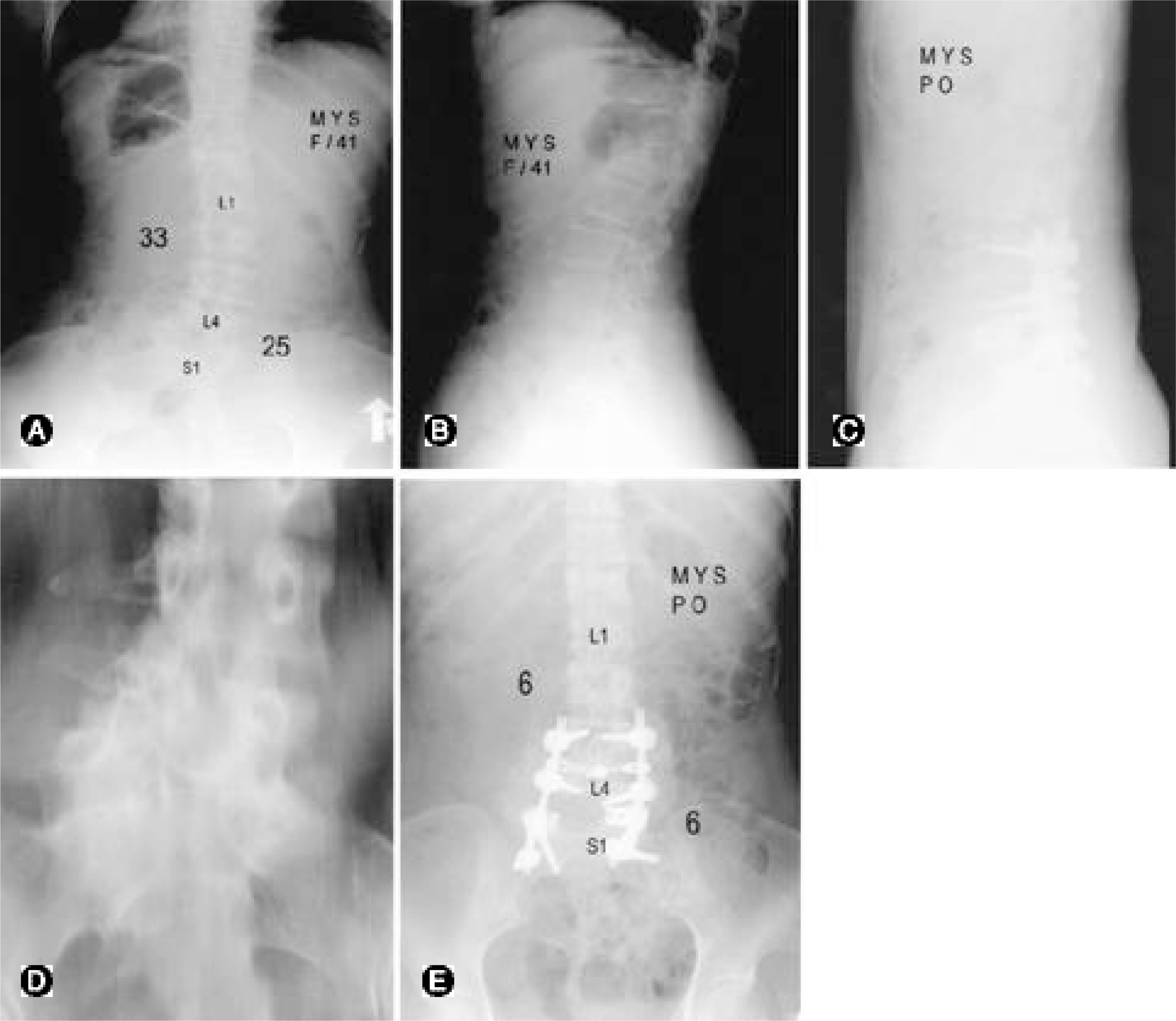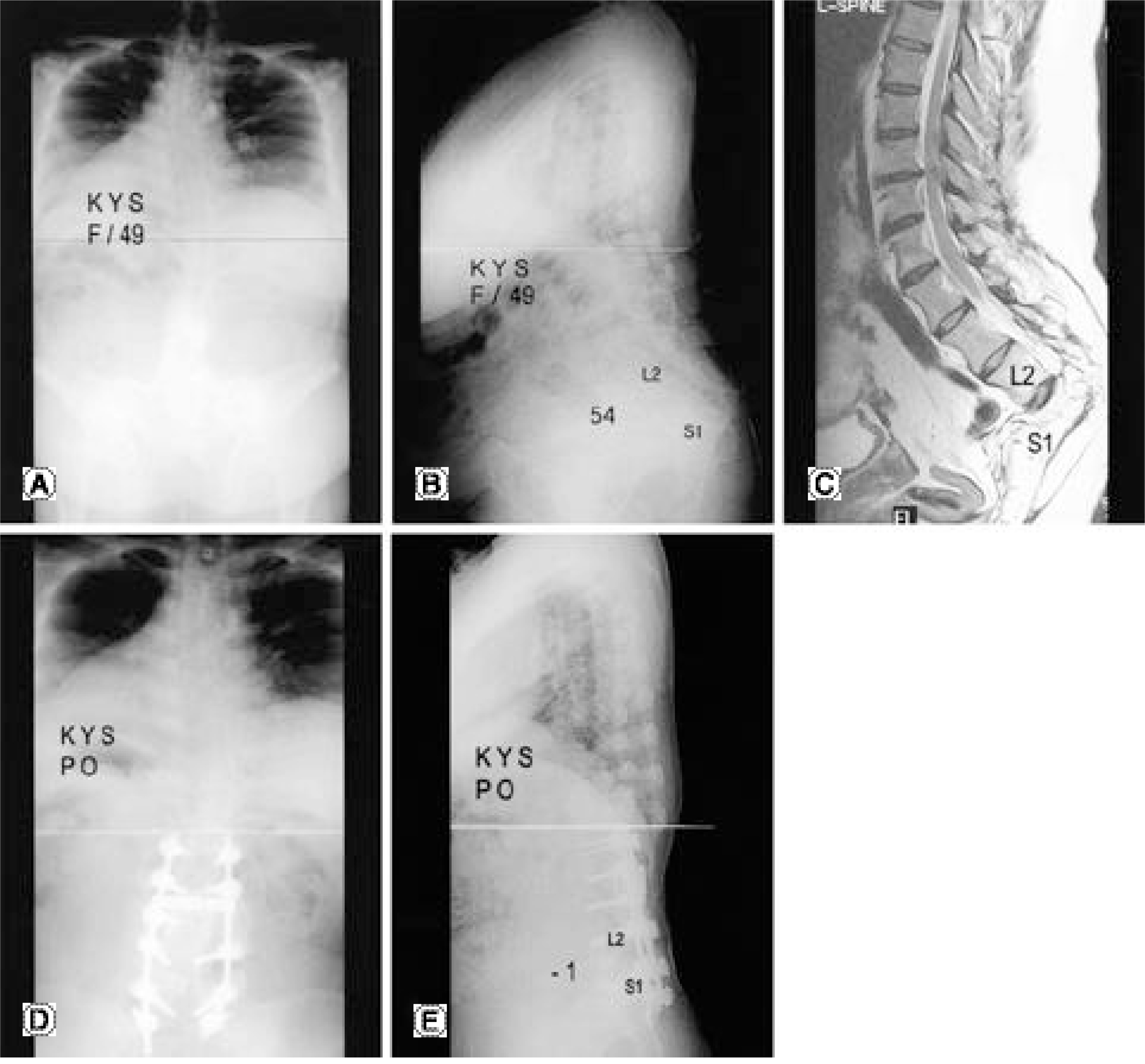J Korean Soc Spine Surg.
2004 Jun;11(2):90-98. 10.4184/jkss.2004.11.2.90.
Posterior Vertebral Column Resection (PVCR) in Fixed Lumbosacpal Deformity
- Affiliations
-
- 1Seoul Spine Institute, Inje University Sanggye Paik Hospital, Korea. dragon@sanggyepaik.ac.kr
- 2Department of Orthopaedic Surgery, National Medical Center, Korea.
- 3Department of Orthopaedic Surgery, Boramae Municipal Hospital, Korea.
- KMID: 2097815
- DOI: http://doi.org/10.4184/jkss.2004.11.2.90
Abstract
- STUDY DESIGN: A retrospective study.
OBJECTIVES
To report the results and techniques of posterior vertebral column resections for fixed lumbosacral deformity. SUMMARY OF LITERATURE REVIEW: Fixed lumbosacral deformity results in gross imbalance and progressive compensatory thora-columbar deformity due to the absence of a mobile spine caudally. MATERIAL AND METHODS: Twenty-five consecutive fixed lumbosacral deformity patients subjected to PVCR were reviewed after a minimum follow-up of 2 years. The offending vertebra was below the L4 in all cases. The etiological diagnoses were congenital scoliosis, congenital kyphoscoliosis, post-traumatic kyphosis and post-infectious kyphosis in 6, 3, 2 and 14 patients, respectively. The average age at the time of operation was 38 years, with a male:female ratio of 7:18. The indication for PVCR was fixed lumbosacral deformities that could not be brought to a reasonable balance on traction or forced side bending.
RESULTS
On average 2.1, ranging from 1 to 5, vertebrae were removed, with 52 removed in all. The average fusion extent was 4.5 vertebrae, ranging from 2 to 8. An anterior column reconstruction was carried out with an autogenous bone graft in all patients, with the additional insertion of titanium mesh in 12. The distal anchor went down to the L5, S1 and S2 in 4, 12 and 9 patients, respectively. A preoperative scoliosis of 3812 was corrected to 158 (60% correction), and a preoperative kyphosis of 3525 was corrected to -511 (40% correction). A preoperative coronal imbalance of 2.0cm was improved to 0.9cm, and a preoperative sagittal imbalance of 9.3 cm was improved to 4.6 cm. The mean operation time and blood loss were 280 minutes and 2810ml, respectively. Following complications were encountered in 5 patients: 2 transient neurologies, 2 compression fractures at proximal adjacent vertebra and 1 pseudoarthrosis.
CONCLUSIONS
A posterior vertebral column resection is an effective procedure for the management of a fixed lumbosacral deformity. It provides satisfactory correction and improved functional outcomes. However, it is a technically demanding and exhausting procedure, with possible risks for complications
MeSH Terms
Figure
Reference
-
1). Leong JC, Day GA, Luk KD, Freedman LS, Ho EK. Nine-year mean follow-up of one-stage anteroposterior excision of hemivertebrae in the lumbosacral spine. Spine. 1993; 18:2069–74.
Article2). Slabaugh PB, Winter RB, Lonstein JE, Moe JH. Lumbosacral hemivertebrae. A review of twenty-four patients, with excision in eight. Spine. 1980; 5:234–44.3). Winter RB, Moe JH, Eilers VE. Congenital scoliosis. A study of 234 patients treated and untreated. J Bone Joint Surg [Am]. 1968; 50A:1–47.
Article4). Leatherman KD. The management of rigid spinal curves. Clin Orthop. 1973; 93:215–24.
Article5). Deviren V, Smith JA, Emami A, Hu SS, Bra dford DS. Management of fixed sagittal plane deformity: results of the transpedicular wedge resection osteotomy. Spine. 2001; 26:2036–43.6). Bradford DS, Tribus CB. Vertebral column resection for the treatment of rigid coronal decompensation. Spine. 1997; 22:1590–9.
Article7). Suk SI, Kim JH, Lee SM, et al. Posterior vertebral colu mn resection for severe spinal deformities. J Kor Orthop Assoc. 2003; 38:72–78.8). Suk SI, Kim JH, Kim WJ, et al. Treatment of fixed lumbosacral kyphosis by posterior vertebral column resection. J Kor Spine Surg. 1998; 5:307–313.9). Fisk JR, Winter RB, Moe JH. The lumbosacral curve in idiopathic scoliosis. Its significance and management. J Bone Joint Surg [Am]. 1980; 62A:39–46.
Article10). Royle ND. The operative removal of an accessory vertebra. Med J Aust. 1928; 1:467.
Article11). Leatherman KD, Dickson RA. Two-stage corrective surgery for congenital deformities of the spine. J Bone Joint Surg [Br]. 1979; 61B:324–8.
Article12). Bradford DS, Boachie-Adjei O. One-stage anterior and posterior hemivertebral resection and arthrodesis for congenital scoliosis. J Bone Joint Surg [Am]. 1990; 72:536–40.
Article13). Smith-Peterson MN, Larson CB, Aufranc OE. Osteotomy of the spine for correction of flexion deformity in rheumatoid arthritis. J Bone Joint Surg [Am]. 1945; 27:1–11.14). Heinig CF, Boyd BM. One stage vertebrectomy or eggshell procedure. orthopaedic transaction. J Bone Joint Surg [Am]. 1985; 9:130.15). Thomasen E. Vertebral osteotomy for correction of k y p h osis in ankylosing spondylitis. Clin Orthop. 1985; 194:142–52.16). Floman Y, Micheli LJ, Penny JN, Riseborough EJ, Hall JE. Combined anterior and posterior fusion in seven -ty-three spinally deformed patients: indications, results and complications. Clin Orthop. 1982; 164:110–22.17). Kostuik JP, Maurais GR, Richardson WJ, Okajima Y. Combined single stage anterior and posterior osteotomy for correction of iatrogenic lumbar kyphosis. Spine. 1988; 13:257–66.18). Sponseller PD, Cohen MS, Nachemson AL, Hall JE, Wo hl ME. Results of surgical treatment of adults with idiopathic scoliosis. J Bone Joint Surg [Am]. 1987; 69:667–75.
Article
- Full Text Links
- Actions
-
Cited
- CITED
-
- Close
- Share
- Similar articles
-
- Posterior Vertebral Column Resection for Severe Spinal Deformities
- Treatment of Fixed Lumbosacral Kyphosis by Posterior Vertebral Column Resection: A preliminary report
- Total Deformity Angular Ratio as a Risk Factor for Complications after Posterior Vertebral Column Resection Surgery
- Three-Column Osteotomy for the Treatment of Rigid Cervical Deformity
- Complications of Posterior Vertebral Resection for Spinal Deformity



